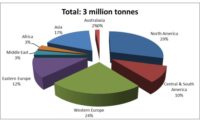The market for packaging coatings is expected to increase to 2020

Through 2020, the market for packaging coatings is expected to increase 1.9% per year to 60 million gallons. Gains will represent a strong acceleration in growth compared with the 2010-2015 performance, in which demand was nearly flat. Demand for packaging coatings will match gains in packaging shipments through 2020, although coating requirements will be limited to some degree by the utilization of more efficient coatings and application technologies. However, coatings demand will benefit from healthy growth in paper packaging shipments and an acceleration in the output of metal packaging.
According to analyst Matt Hurley, “Coatings will continue to be valued in the packaging industry for their ability to impart performance enhancing qualities such as barrier properties and antistatic capabilities.” These and other trends are presented in "Manufacturing (OEM) Coatings Market in the U.S.," a new study from The Freedonia Group (freedoniagroup.com).
Packaging coatings are used to protect both the interior and exterior of rigid containers, chiefly food containers and beverage cans. Interior coatings are designed to protect the interior surface of packaging materials from contact with their contents, while exterior coatings are intended to enhance the container’s appearance. Other applications include aerosol cans, bottle crowns for glass and plastic packaging, and glass bottle closures. Coatings are also important in other markets as well, such as toiletries (e.g., shaving cream or mousse, and aerosol cans) and the chemical industry (e.g., containers and metal drums, and paint cans).
As a result of safety and environmental concerns, there has been a shift away from solvent-based coatings and those containing BPA in food-contact applications. This has also produced changes in can design and shifts in canning and soldering techniques. Suppliers of can coatings have also had to meet increasingly stringent environmental requirements related to the emission of volatile organic compounds from their products. As a result, water-based, radiation cured, and powder coatings continue to expand their market share in can coatings.
Looking for a reprint of this article?
From high-res PDFs to custom plaques, order your copy today!





